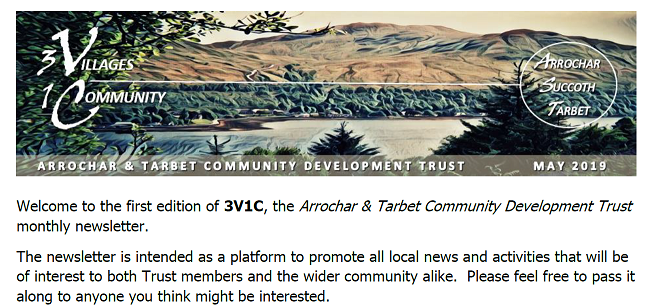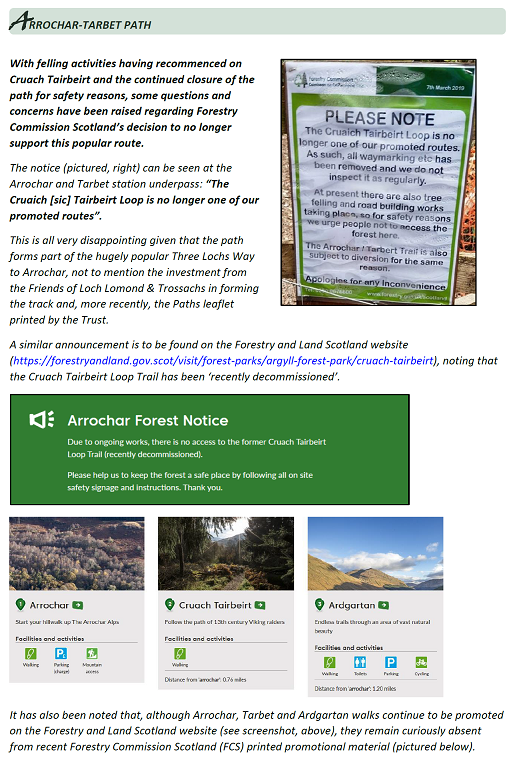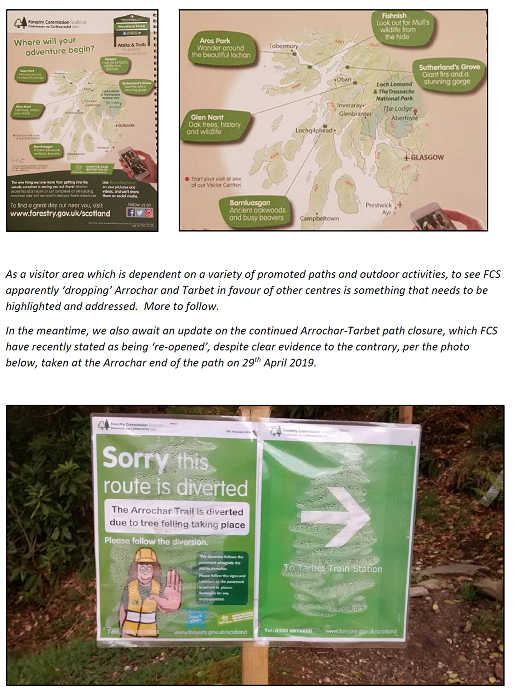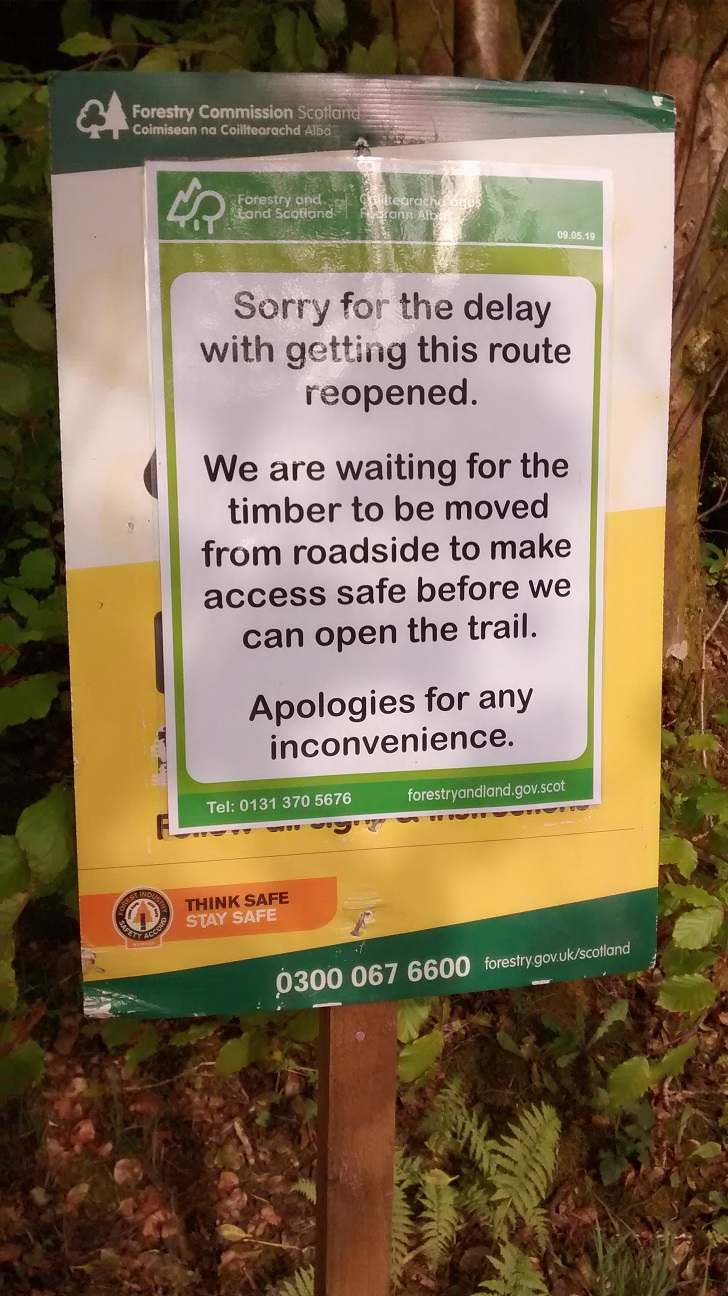 Access issues created by the Forestry Commission – now Forest and Land Scotland – feature prominently in the first edition of the new Arrochar-Succoth-Tarbet community newsletter.
Access issues created by the Forestry Commission – now Forest and Land Scotland – feature prominently in the first edition of the new Arrochar-Succoth-Tarbet community newsletter.

Parkswatch first blogged about the longstanding access problems at Cruach Tairbeart, which forms a fine viewpoint between the head of Loch Long, a year ago (see here). A friend of mine visited recently to find a barrier sitting across the underpass at Arrochar Station – most off-putting and almost certainly an unlawful obstruction to access. On this occasion tree felling was taking place around the Cruach Tairbeart path, unlike other times when no entry signs have been in place here, and there could have been no objections to helpful signs in the right place. The felling, however, did not affect ALL paths accessible from the station and there was no indication of what paths could still be used safely or of recommended alternative routes. People were, as a consequence, still walking there.
The forest felling has been taking place here intermittently over a couple of years. It should have been an ideal opportunity for Forest and Land Scotland to create and or waymark alternative routes to the summit of Cruach Tairbeart, a small hill which enables people to experience fine views of Loch Lomond without the effort required to ascend the higher peaks round about. That would have enabled people to continue to enjoy the hill during the felling. Instead they have shut the main path (others have become overgrown), closing off a tourism opportunity

Even more worrying is the revelation from the Arrochar and Tarbet Community Development Trust that Forestry and Land Scotland appear to have decided to “decommission” the Cruach Tairbeart route entirely and its no longer appearing on publicity materials.
Had the Cruach Tairbeart loop all been designated as a core path, Forest and Land Scotland would have been unable to “decommission” it and would have had to seek approval from the National Park Authority for any temporary closure. This is the very reason why the revised Core Paths Plan consulted on by the LLTNPA should have included proposals to add far more forestry tracks/paths. Its also probably explains why this did not happen. Some local managers appear to want to be free to close paths permanently, as if our access legislation had never existed, without having to think about the wider implications.

This “decommissioning”, however, also appears to be contrary to the Cruach Tairbeart Design Plan 2015 – 2024 (see here). While that plan contained no specific proposals for paths that I can see – a failing that needs to be put right – it did make this commitment:
Recreation: Informal recreation use will be maintained and the setting of paths enhanced. In addition, scope for a cycle route through the forest to provide an alternative route to the A82 along Loch Lomond will be explored.
So why is Forest and Land Scotland ignoring its own plan, who decided to do this and who did they consult?

When I contacted the local community about all this, they did send me a recent photo of a new sign that has gone up explaining why the Arrochar-Tarbet path has not been re-opened as promised in April (above). A small step in the right direction.
What needs to happen
Forest and Land Scotland needs a far more robust plan for access and outdoor recreation for the extensive landholdings it manages in the Loch Lomond and Trossachs National Park to prevent situations like that at Cruach Tairbeart recurring. The starting point for this should be the standards that have been agreed for the management of access as part of the Scottish Outdoor Access Code (there is no need to reinvent all the good work that has been done). The LLTNPA’s draft Trees and Woodland Strategy for the National Park, which is out for consultation until Friday 2nd June (see here), refers to the SOAC and says access will be promoted in forests. The problems is this is not always happening at present and the Strategy should indicate how this will be addressed.
The wider problem, however, is that too many forests in the National Park are being managed or designed without access and outdoor recreational being held sufficiently in mind. Hence, I suspect, the position at Cruach Tairbeart. The Woodland Strategy should commit Forest and Land Scotland to work with the National Park and other recreation interests to produce a much more comprehensive path network over the next five years. As a start all new Forest Plans should contain clear proposals for outdoor recreation that meet the standards we should expect in our National Parks

These path closures both in Arrochar and elsewhere are a consequence of a “British Empire” approach to forestry in the UK. During its 100 year existence the Forestry Commission’s operations in Scotland resembled the systems used by colonial foresters. In far away places forests were exploited by cutting down huge tracts of native trees so that the Empire, or at least the UK bit, could prosper. In due course these colonial foresters returned home and introduced industrial forestry to Scotland, showing blatant disregard for native Scots pine and oak woods and plastering our hills and blanket bogs with sterile plantations of exotic conifers. The primary purpose of such called forestry was to help big landowners and rich celebrities with their tax affairs. The consequences of this system are seen today in massive, ugly felling operations, blocked paths and trails and scarred landscapes. Extracting the wood requires monster trucks on motorway style forest roads built from new quarries gouged from the hillside. Too many foresters still think they are growing trees like barley or carrots, with little appreciation of the difference between a crop grown on gently undulating land in the lowlands and the constraints imposed by steep hillside terrain. Such forestry is not permitted in any other European country. Scotland’s new forestry organisations need to put colonial forestry behind them, massively reduce the size of felling areas and leave enough trees to ensure most restocking in the hills is through natural regeneration. Intensive forestry in the future needs to be focussed on the lowlands, with more ecologically sound processes allowed to restock the uplands, free of charge.